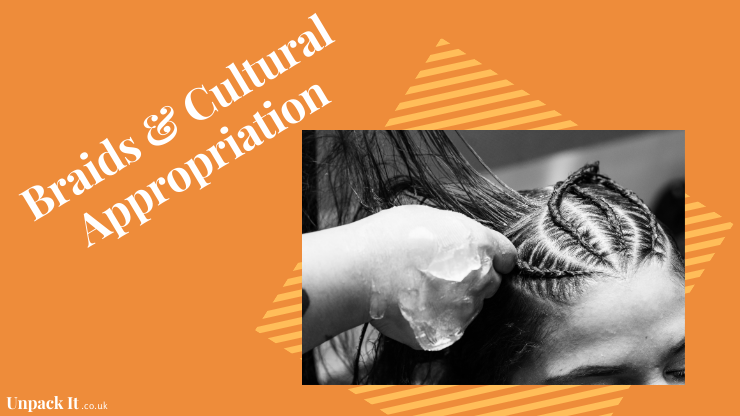Over the past few decades we have seen white women fashion braids and cornrows, particularly within the celebrity world as the media praises their looks. However, this has also sparked controversy and deemed as cultural appropriation by black communities and all over social media. But why? Isn’t it just a hairstyle that anyone can wear to express themselves? Not exactly. There is much more to cornrows and braids than just being a hairstyle. It has a long history with a sense of identity and community attached to it which needs unpacking in order to understand why it’s deemed as an inappropriate cultural trend for white women to fashion.
A Very Brief History Lesson

Braids are a significant part of a black women’s identity and can be dated as far back as 3500 B.C.[1] Not only were they fashionable but they served as a ‘societal custom’[2]. It was like your social security number. Just by looking at a woman’s braids, you could identify many things about them. Such as what tribe they were from, their age, marital status and more. These intricate hairstyles were passed down through generations with great pride to continue to honour the traditions, heritage and artistry of their ancestors. Yet the transatlantic slave trade disrupted (to say the least) such traditions.
During slavery when the colonisers would board their captives onto their ships, the first thing they would do was shave men and women’s hair off to strip them from their identity and make them feel less human by detaching them from their cultures.
Throughout slavery, braids slowly turned from a sense of identity to a form of survival and practicality. Sunday was the only day in the week enslaved people had some time to themselves. Women dedicated this time to braid practical hairstyles that would last a whole week of unimaginable labour in appalling working conditions. One of the most practical styles was cornrows.
Fast forward to the 20th century, when African Americans began to migrate from the rural south to cities of the north in hopes for a better life, they were faced with conforming to the ideals in society that were built for white people. This had a significant impact on black women’s hairstyles as braids and cornrows did not conform to euro centric beauty standards. Braided hair looked dated, lower class and not citified. So women used hair relaxer, wigs, and weaves to not only fit in to the ideal of beauty in the white person’s eyes, but to help secure employment. With their new life in the cities, many chose to assimilate, and straight styles became the fashionable norm to ensure they were not segregated any more than they already were.
Assimilation vs Appropriation
Bo Derek, an American actress, was the first white women to have been widely seen styling cornrows in a film called ‘10’ back in 1979. The fashion of cornrows and braids took off in pop culture from this moment onwards. We’ve seen many other white women fashion the style in the media from Christina Aguilera to Kim Kardashian.

Cornrows even became known as ‘boxer braids’ after female boxers who would wear theif hair in cornrows during a match. Calling the hairstyle boxer braids is offensive as it completely disregards and white washes the rich history and culture behind them.
The primary problem lies in the fact that there is a clear double standard. Black women are told braids or their natural hair isn’t seen professional at work to the extent of being let go from their jobs because of looking “too ethnic” or “ghetto”. Whilst white women are ‘heralded as trendsetters introducing a style’.[3] As Zeba Blay writes in this piece for HuffPost, “White women are able to wear black hairstyles without the stigma of actually being black.”[4]
A counterargument regularly used is; “well black women wear blonde wigs and straighten their hair. Clearly they want to be like us so why can’t we wear braids?” It’s not the same thing. When black women move away from their natural hair styles it more often exemplifies assimilation than appropriation. ‘In a culture where black women are penalized for their natural hair, changing it to look more like the dominant culture, is a means for survival.’[5] There are no societal pressures in the western world that white people need to assimilate to Afrocentric beauty standards.
Suggestions
By not acknowledging the origins of cornrows and braids, we neglect the history of a race and the community that has kept it so relevant all these centuries and the culture that it’s tied to. We should strive for cultural appreciation, where we reference the cultures we are inspired by, work with people from that culture and ensure people know about the story behind it.
So if you have thoughts about getting your hair braided, despite the fact that natural straight hair cannot handle braids, think about the above and make sure to support the people and communities from the culture you want to take from.
[1] Ebony, The History of Box Braids
[2] Essence, Respect Our Roots: A Brief History of Our Briads
[3] Elle, Braids and Appropriation in America
[4] Huffpost, It’s a Slap in the Face when White Women Wear Black Hairstyles
[5] Bustle, 7 Things You Might Not Realize Are Cultural Appropriation, But Are
References
Bustle, 7 Things You Might Not Realize Are Cultural Appropriation, But Are
Ebony, The History of Box Braids
Elle, Braids and Appropriation in America
Essence, Respect Our Roots: A Brief History of Our Briads
History, The Great Migration
Huffpost, It’s a Slap in the Face when White Women Wear Black Hairstyles
Share post



